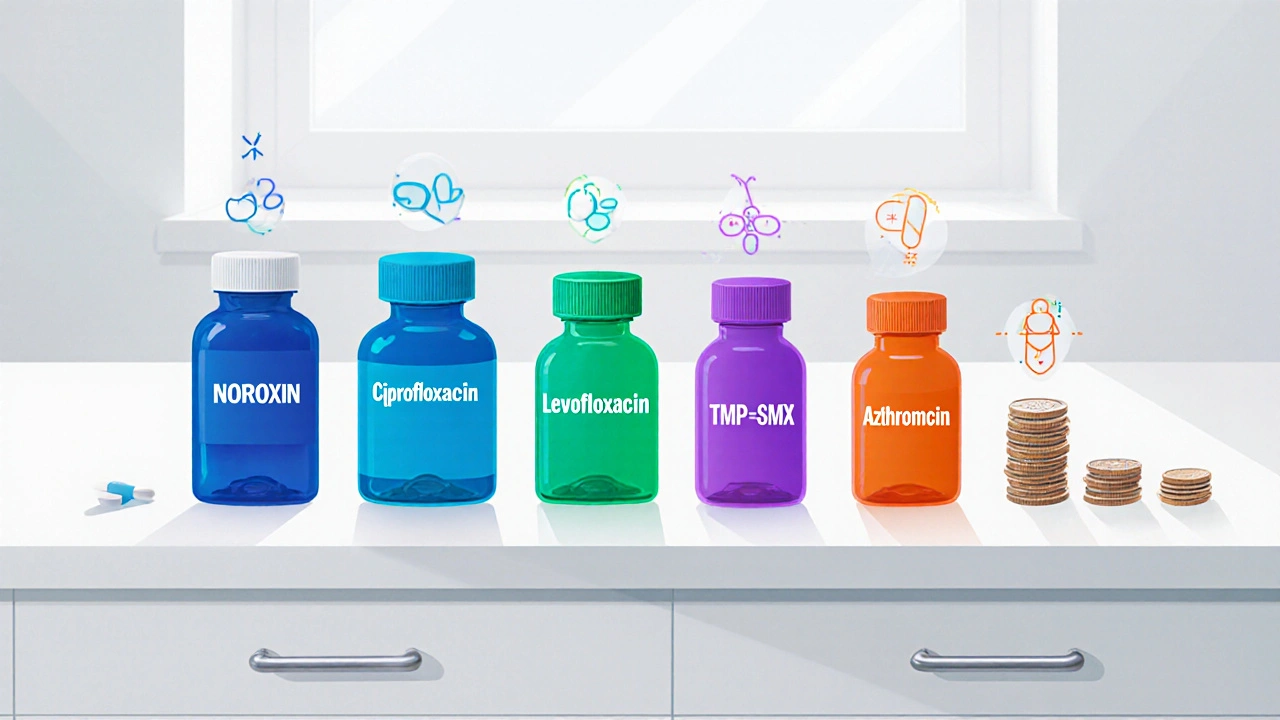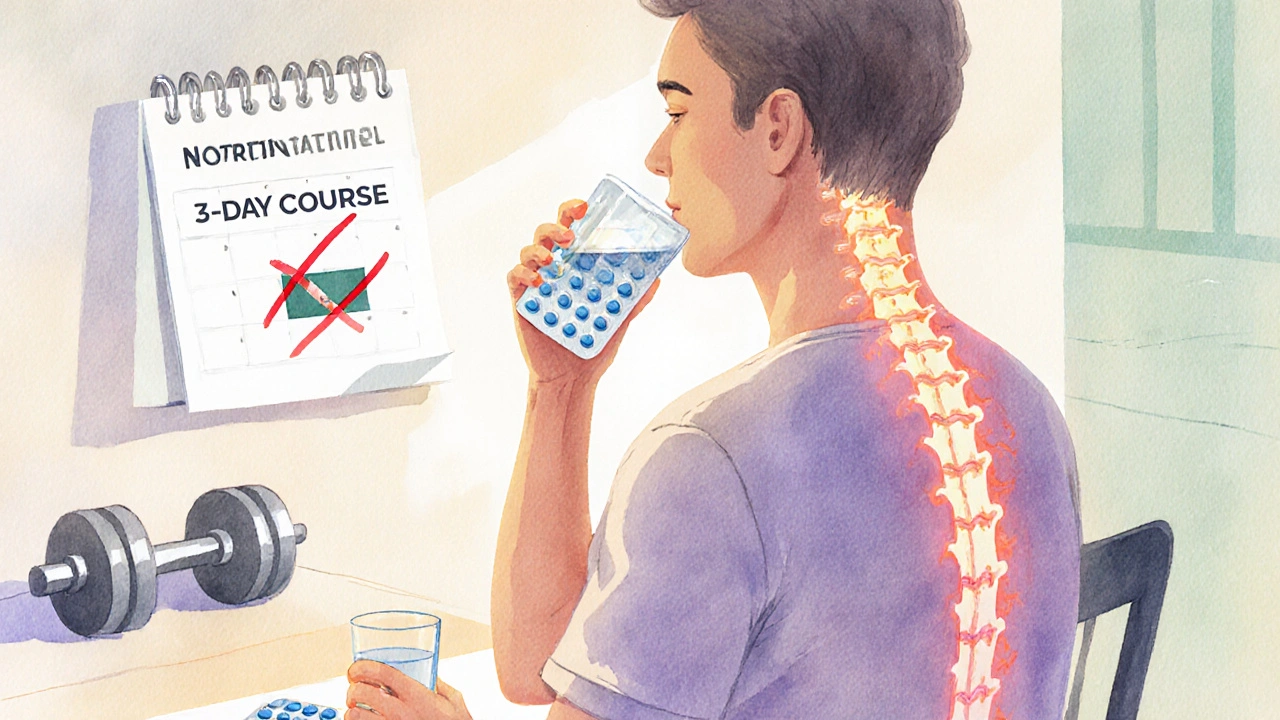Quick Takeaways
- Noroxin (Norfloxacin) is a fluoroquinolone with strong activity against urinary‑tract pathogens but limited coverage for respiratory bugs.
- Ciprofloxacin and Levofloxacin share the fluoroquinolone class, offering broader Gram‑negative reach, yet they carry similar safety warnings.
- Trimethoprim‑sulfamethoxazole (TMP‑SMX) is a good oral option for uncomplicated UTIs when resistance to fluoroquinolones is high.
- Ofloxacin provides a middle ground-slightly better respiratory coverage than Norfloxacin with a comparable side‑effect profile.
- Cost, dosing convenience, and patient‑specific risk factors (tendon issues, QT prolongation, renal function) often decide which drug is the best fit.
Noroxin is a brand name for Norfloxacin, a second‑generation fluoroquinolone antibiotic that interferes with bacterial DNA gyrase and topoisomerase IV, halting DNA replication. It was approved in the early 1990s and is most frequently prescribed for uncomplicated urinary‑tract infections (UTIs) and certain gastrointestinal infections caused by susceptible bacteria.
How Noroxin Works and When It’s Used
By binding to the enzymes that unwind bacterial DNA, Norfloxacin prevents the bacteria from reproducing. This mechanism gives it a bactericidal effect, meaning it kills the pathogen rather than just stopping its growth.
Typical adult dosing for a UTI is 400mg taken orally every 12hours for 3days. For travelers’ diarrhea caused by Shigella or Campylobacter, the dose may be 400mg once daily for 5days. The drug is excreted largely unchanged in the urine, which explains its high concentrations in the urinary tract.
Key Factors to Compare Antibiotics
When you line up Noroxin against other agents, consider these six dimensions:
- Spectrum of activity - which bacteria are reliably killed?
- Dosage schedule - how many pills per day and for how long?
- Pharmacokinetics - half‑life, renal clearance, tissue penetration.
- Safety profile - risks of tendon rupture, QT prolongation, CNS effects.
- Resistance trends - local susceptibility patterns from antibiograms.
- Cost and convenience - price per course and whether the drug is widely stocked.

Popular Alternatives to Noroxin
Ciprofloxacin is a broad‑spectrum fluoroquinolone with strong Gram‑negative and moderate Gram‑positive activity, often used for complicated UTIs, prostatitis, and certain abdominal infections.
Levofloxacin belongs to the same class but offers once‑daily dosing and enhanced lung penetration, making it a go‑to for community‑acquired pneumonia and sinusitis.
Ofloxacin is another fluoroquinolone that sits between Norfloxacin and Ciprofloxacin in terms of spectrum; it’s useful for both urinary and respiratory infections.
Trimethoprim‑sulfamethoxazole (TMP‑SMX) is a sulfonamide combo that works well for many uncomplicated UTIs, especially when fluoroquinolone resistance is high.
Azithromycin is a macrolide that covers atypical respiratory pathogens; it’s not a direct UTI drug but often appears as an alternative for mixed infections.
Side‑Effect Profile: Noroxin vs. Its Peers
All fluoroquinolones share a boxed warning for tendon rupture, peripheral neuropathy, and QT‑interval prolongation. However, the incidence varies slightly:
- Noroxin: Tendon events reported in ~0.1% of users; mild GI upset is the most common complaint.
- Ciprofloxacin: Slightly higher GI upset rate; also linked to rare hepatotoxicity.
- Levofloxacin: Similar tendon risk, but a bit more frequent central nervous system effects (dizziness, insomnia).
- Ofloxacin: Comparable side‑effect profile to Noroxin, with a marginally higher rate of photosensitivity.
- TMP‑SMX: Rash and occasional blood‑count suppression; no tendon concerns.
- Azithromycin: Generally well tolerated, but carries a risk of significant QT prolongation, especially with other cardiotoxic drugs.
Cost and Convenience Snapshot
Pricing can shift by pharmacy and insurance, but a typical 7‑day course in the United States looks like this (average retail price, no insurance):
| Agent | Typical Dose (UTI) | Course Length | Half‑Life (hrs) | Common Side Effects | Average Cost (USD) |
|---|---|---|---|---|---|
| Norfloxacin | 400mg PO q12h | 3days | 5-6 | GI upset, tendon pain | $30‑$45 |
| Ciprofloxacin | 500mg PO q12h | 5‑7days | 3-4 | nausea, photosensitivity | $25‑$40 |
| Levofloxacin | 750mg PO daily | 5days | 6-8 | CNS effects, QT prolongation | $35‑$55 |
| Ofloxacin | 400mg PO q12h | 5‑7days | 5-6 | Photosensitivity, tendon pain | $28‑$42 |
| TMP‑SMX | 800mg PO q12h | 3days | 10 | Rash, rare blood‑count changes | $15‑$25 |

Choosing the Right Agent for Different Scenarios
Uncomplicated UTI in a healthy adult: Norfloxacin works well if the local E.coli resistance rate is below 10%. If resistance is higher, TMP‑SMX or a short course of Cefdinir might be safer.
Complicated UTI or prostatitis: Levofloxacin’s once‑daily dosing and better prostate penetration often make it the preferred fluoroquinolone.
Respiratory infection (pneumonia, sinusitis): Levofloxacin or Azithromycin offer superior lung coverage; Norfloxacin is generally not recommended.
Patient with a history of tendon issues or on corticosteroids: Avoid all fluoroquinolones, including Norfloxacin. Consider TMP‑SMX or a beta‑lactam instead.
Renal impairment (CrCl < 30mL/min): Dose‑adjust Norfloxacin or switch to Levofloxacin, which has more flexible renal dosing guidelines.
Practical Tips for Patients on Fluoroquinolones
- Take the medication with a full glass of water and stay upright for at least 30minutes to reduce tendon irritation.
- Avoid high‑impact sports or heavy lifting for two weeks after finishing therapy.
- Check for drug interactions: antacids, sucralfate, and minerals (calcium, iron) diminish absorption; separate them by at least 2hours.
- Report any sudden joint pain, swelling, or tingling sensations immediately.
- Complete the full course even if symptoms improve; early stopping fuels resistance.
Frequently Asked Questions
Is Noroxin still effective against common UTI bugs?
Yes, when local E.coli resistance is under 10%, Norfloxacin remains a solid first‑line choice. Checking your clinic’s antibiogram gives the most reliable answer.
Can I take Noroxin if I’m pregnant?
Fluoroquinolones are classified as Pregnancy Category C. They should be avoided unless the benefits outweigh potential risks. Safer alternatives like nitrofurantoin are usually preferred.
What should I do if I develop tendon pain while on Noroxin?
Stop the medication immediately and contact your healthcare provider. They will likely switch you to a non‑fluoroquinolone antibiotic and may order imaging if the pain is severe.
How does the cost of Noroxin compare to generic ciprofloxacin?
Both are available as generics, but ciprofloxacin often has a slightly lower retail price ($25‑$40) compared to Norfloxacin ($30‑$45). Insurance formularies may make one cheaper than the other.
Can I use antacids with Noroxin?
Antacids containing aluminum or magnesium bind fluoroquinolones and cut absorption by up to 60%. Take them at least two hours apart from Norfloxacin doses.
By weighing spectrum, safety, cost, and personal health factors, you can decide whether Noroxin or one of its alternatives is the best fit for your infection. Always discuss options with a pharmacist or prescriber, especially if you have comorbidities or are on other medicines.


Bernard Lingcod
Hey folks, glad you dug into the Noroxin rundown-there’s a lot to unpack here. If you’re weighing the fluoroquinolone options, start by checking your local antibiogram; a 10 % E. coli resistance threshold is the sweet spot for Norfloxacin. For patients with mild renal impairment, a modest dosage tweak keeps plasma levels therapeutic without piling on toxicity. Remember, a twice‑daily schedule can be a hassle, so weigh convenience against spectrum when you pick between Ciprofloxacin and Levofloxacin. Stay sharp and keep the best evidence at your fingertips!